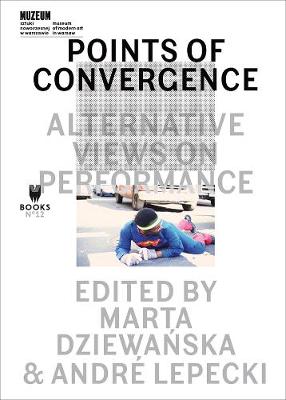MODERN PROBLEMS IN OPHTHALMOLOGY SEE 0322 REF KARGER
3 total works
Points of Convergence – Alternative Views on Performance
by Marta Dziewanska and Andre Lepecki
Published 21 April 2017
Thanks to its very nature, performance enters into natural dialogue with art, new media, politics, and the social sphere as a whole. Always happening in the here and now, and with a unique freedom and openness to the unknown, performance is a medium with a special ability to question its own subjects, materials, and languages. As a result, it is often best reflected in the dynamic character of contemporary art and contemporaneity in the broadest sense of the word. Points of Convergence explores these ideas and investigates critical approaches to performance, ultimately aiming to stimulate new discussion between theorists and practitioners.
With twelve essays by leading figures in the field of performance arts, this illustrated volume is structured in two parts. The first, authored by academics in the discipline, features an introduction to key areas of scholastic research. The second part, authored by curators and other researchers, then focuses on an account of individual traditions of performance. Taken together, the contributions identify new possibilities for interaction between the theoretical aspects of performance art and the ways performance plays out within local contexts.
With twelve essays by leading figures in the field of performance arts, this illustrated volume is structured in two parts. The first, authored by academics in the discipline, features an introduction to key areas of scholastic research. The second part, authored by curators and other researchers, then focuses on an account of individual traditions of performance. Taken together, the contributions identify new possibilities for interaction between the theoretical aspects of performance art and the ways performance plays out within local contexts.
One of Poland's most important and independent postwar artists, Andrzej Wroblewski (1927-57) created in his short life his own highly individual, suggestive, and prolific form of abstract and figurative painting that continues to inspire artists today. This volume offers a stunning presentation and thorough reevaluation of his work and its legacy in the international context of art history. Offering an insightful picture of the world of postwar painting in communist Europe, and highlighting Wroblewski's political engagement, the book helps us to understand the immensely evocative vision of war and oppression that he created. This close look at a painter and a period that are of growing interest for international art historians will serve to further cement Wroblewski in the postwar pantheon.
The work of Slovak sculptor Maria Bartuszova (1936-96) was first presented to international audiences in Kassel in 2007. Although her art has appeared in influential exhibitions and been included in prestigious contemporary art collections, up until now, she has yet to receive the widespread recognition she deserves. Dziewanska's book offers distinct perspectives on Bartuszova's work from renowned international critics in an effort to increase our awareness of her sculptures. Working alone behind the Iron Curtain, Bartuszova was one of a number of female artists who not only experimented formally and embarked intuitively on new themes, but who, because they were at odds with mainstream modernist trends, remained in isolation or in a marginalized position. Revealing her dynamic treatment of plaster-a material that, from a sculptor's point of view, is both primitive and common-the book deftly reveals how Bartuszova experimented with materials, never hesitating to treat tradition, accepted norms, and trusted techniques as simply transitory and provisional.
Offering a much-needed history of a vibrant body of work, Maria Bartuszova: Provisional Forms is an important contribution to the literature on great female artists.
Offering a much-needed history of a vibrant body of work, Maria Bartuszova: Provisional Forms is an important contribution to the literature on great female artists.


